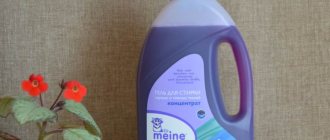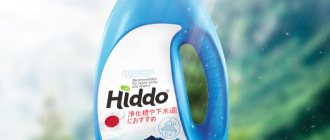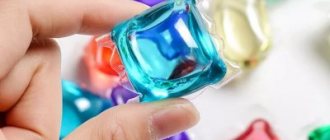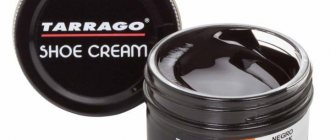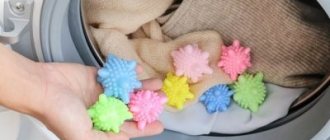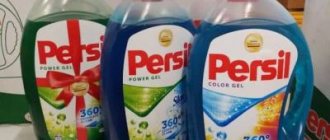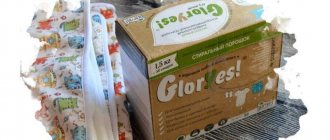The arrival of a baby in the house always brings new worries and questions. How to feed, what to wear, how much to sleep and... how to wash diapers? Stains on children's clothing are often difficult to remove, and it is not recommended to use aggressive chemicals for washing in this case. Therefore, washing powders in the household cabinets of young parents are gradually replacing modern liquid detergents.
Advantages of gels over washing powder - let’s look at the properties and composition
The Russian market offers a lot of detergents for washing children's clothes and diapers: the range is almost comparable to that for adults. But it is gels for washing children's clothes that are leading in sales today.
Which children's washing powders do you choose - an independent rating of powders for washing children's clothes from colady.ru
Why are liquid products preferable, and what causes such interest among mothers in them?
So, the main advantages of washing gels in comparison with powder detergents:
- Convenient to dose. The powder is usually poured in “by eye”, and for dosing the gel, a bottle cap is used, which does not get lost anywhere, being screwed to the container.
- Convenient to store. The bottle closes tightly, nothing spills, does not generate dust, does not get wet and does not require additional packaging.
- Rinse the laundry more thoroughly.
- Dissolve faster. Washing powder takes much longer to dissolve, which means it begins to act on laundry later.
- More effective with short washes and cold water.
- They have less aggressive compositions and contain less surfactants.
- Effective for all types of fabrics.
How to use?
The amount of gel per wash is calculated based on the weight of the laundry. This indicator is reflected on the packaging. A cap is often used as a measuring cup .
A measured volume of balm is poured into the washing machine compartment intended for powder or directly onto items placed in the drum. Next, set the mode and temperature. These parameters are selected based on the quality and color of the products.
Liquid products cope better with contaminants if they are used in an automated manner. Hand washing with gel is less effective.
For newborns, you should use products that have an increased threshold of hygienic safety . This sign is reflected on the bottle in the form of the inscription “0+”. Despite the fact that gels are well rinsed from fabric, when washing newborn clothes, it is advisable to use double rinsing.
For older children, you can use any gels from the children's category. They are washed in the standard way. The most important thing is not to increase the recommended dose of the product and not to set the water heating temperature to high.
Liquid laundry detergents - what composition is acceptable in children's laundry detergents?
Typically, powders and gels contain the following components:
Surfactants
Usually no laundry detergent can do without this component. The key task of surfactants is to remove contaminants from fabric. The effectiveness of surfactants increases with the water temperature during washing.
In powders, the optimal surfactant concentration is about 20%; in gels it can reach up to 50%. It is surfactants in laundry detergents that cause up to 80% of allergic manifestations on children's skin, so the optimal concentration of these substances in the product used should not exceed the permissible values - 7%, according to European standards.
It is important to note that surfactants can be:
- Anionic (the most aggressive). They tend to settle in the body and gradually destroy the integrity of cells, affecting internal organs.
- And non-inogenic. These substances are safe and practically harmless. Typically, detergents containing these surfactants do not lather well and have poorer washing characteristics. But spots are spots, but health is more important?
- There are also tensides. If you see this exact word on the packaging, then know that this is the same aggressive surfactant, disguised by the manufacturer under a pleasant word.
- Soap. The same surfactant, only of plant-animal origin. Despite its many advantages, soap still has the property of forming free alkali when dissolved in water, which further leads to dry skin and irritation. However, according to ECO criteria, soap is considered a pure product.
On a note:
- To wash children's underwear, choose products that contain non-ionic substances or natural, environmentally friendly surfactants.
- Visually, the concentration of surfactants is also determined by the foam: the more foam there is during washing, the more of this substance, the more dangerous the chosen detergent.
Phosphates
Their task is to soften water using calcium/magnesium salts. The softer the water, the more effective the surfactants. In addition, phosphates play the role of a protective agent to prevent scale in washing machines.
Cons: Phosphates are harmful to the environment and humans. In adult laundry detergents, phosphates can be replaced with environmentally friendly zeolites, but they are usually not used in children's detergents due to the fact that the fabric becomes coarser after detergents containing zeolites.
As for health, phosphates are dangerous for everyone, and the list of side effects from constant use of products with these components is very wide.
Phosphorites and phosphonates are considered less aggressive, but they, under certain conditions, may well acquire the properties of phosphates. In addition, to rinse phosphates (or their derivatives) from laundry, you will have to rinse it at least 10 times. For example, the “eared nanny” product can contain up to 30% phosphates.
On a note:
- There should be no phosphates in children's washing gel!
- The safest substitutes for this component are sodium sesquicarbonate, zeolites (the laundry becomes rougher, the pipe quickly becomes clogged, stains remain on the color) and silicates/carbonates.
Optical brighteners
No matter how sweetly manufacturers sing in our ears, these substances are unacceptable in children's laundry detergents! They are not rinsed out when washing, they firmly settle on fabrics, which then, upon contact with the skin, cause itching, allergies and other reactions.
Important:
Optical brightener itself does not have the properties of a bleach. The effectiveness of the component is based on “optical illusion” and fluorescent properties. That is, it is not the laundry that becomes snow-white, but the emission of light occurs in the desired range of the spectrum.
Chlorine
All mothers are very familiar with the characteristic chlorine “aroma”. This substance is often included in products because of its strong whitening effect.
But…
- Chlorine evaporates and negatively affects the body, affecting the lungs first.
- The use of products containing chlorine is prohibited in unventilated areas.
- When chlorine reacts chemically with dirt particles on the laundry being washed, toxic organic chemicals are formed.
Modern manufacturers are trying to replace chlorine with oxygen bleaches. However, we have already noted the harmfulness of the latter above.
Enzymes
The purpose of these additives is to enhance the removal of organic dirt:
- Lipase fights grease stains.
- Protease – with protein spots.
- Cellulase - with the appearance of a gray tint on fabrics.
- Amylase – with starch-containing spots.
The higher the price of the product, the more types of enzymes it contains.
How can you bleach children's clothes and remove stains on them without harming the child's health - the best advice from experienced mothers
Are enzymes safe? Yes. But only for humans. But the fabric quickly becomes unusable from constant contact with enzymes. However, if you can afford frequent wardrobe updates, then feel free to use gels with enzymes.
The effectiveness of enzymes decreases at temperatures above 60 degrees.
Fragrances
This component is just a product disguise and a simple advertising gimmick. Naturally, there is nothing even close to ocean freshness, spring flowers and alpine meadows in laundry detergents.
Moreover, the manufacturer does not consider it his duty to decipher this mysterious word “fragrance”. But powerful allergens can be hidden underneath it, such as components such as hexylcinnamal or butylphenylmethylpropional, which are allergens.
Conclusion:
- Products with fragrances are not recommended for children's underwear.
- Dry your laundry in the fresh air - it will smell no worse. And when washing and storing, you can use natural essential oils.
Why is it best to use liquid powder for baby's things?
The composition of gel-like products intended for cleaning children's things is carefully thought out. They contain few substances that enhance foaming . In most cases, the gels minimize the amount of compounds harmful to the health of babies.
Many washing powders contain fragrances and dyes in their formula, which cause an allergic reaction. They use a large proportion of sulfates and phosphates, which partially remain in the material and can cause problems with the kidneys, liver, lungs, and skin. Gels do not have this drawback.
The ingredients of the baby gel include safe oxygen bleaches and enzymes. They remove stains while preserving the color of the fabric. Moreover, the amount of each substance in different gels differs. For example, the content of surfactants (surfactants) ranges from 2% to 30% .
The consistency of liquid concentrates does not have large abrasive particles as in powder. Therefore, the gel actively penetrates between the fibers of the fabric and also freely comes out of the fabric when rinsing.
Memo to parents on choosing baby gel:
- Safe components: non-ionic surfactants, natural surfactants, natural herbal additives (oils, herbal extracts).
- Give preference to eco-friendly products. Look for the “Eco”, “Hypoallergenic”, “BIO” or “For sensitive baby skin” labels on the packaging. But still read the ingredients carefully! Not all manufacturers are conscientious.
- Consider the company's reputation, but don't trust the "brands." The same children's Persil or Tide contain a significant portion of toxic surfactants.
- Remember that an eco-friendly product with biodegradable components cannot be cheap. You have to pay for security.
- The product should not have a strong odor.
- Do not buy baby gels in the markets - only in large markets or pharmacies, where you can require a certificate for each product.
- The packaging must contain all the information in full: composition, manufacturer and country, purpose and precautions, dosage recommendations, storage conditions.
- Check the tightness of the bottle and the expiration date of the product. A transparent bottle makes it easier to see the quality of the gel. Remember that the shelf life of the gel is significantly shorter than that of powders.
- You can save on safe baby products by buying large packages or doy-packs. But a high price is not an indicator of quality! Again, read the ingredients of the product.
- There are many resources on the Internet today where you can check the properties of all components of household chemicals, their toxicity or safety. Choose a product at home to know exactly what you are buying. In addition, a huge number of laundry detergents (and others) are now being “taken apart” through independent research. Information is not difficult to find.
Rating of the best funds
You can also choose a powder or gel based on positive reviews about manufacturers of household chemicals and the brand of products.
Pigeon
The concentrated product, tested by dermatologists, contains natural ingredients. Gel, which is suitable for colored and plain materials, is used to wash diapers and rompers by hand and in a machine.
Aqua Baby
This liquid product does not contain chemical fragrances or optical brighteners and is designed to care for baby’s belongings from birth. The enzymes present in the composition cope with milk, food and dirt stains.
Amway
The gel with conditioner has a softening effect, rinses well, and does not leave streaks. The liquid does not irritate delicate skin and contains natural ingredients.
Meine Leibe
Hypoallergenic gel is used for hand washing, loaded into a machine, suitable for all types of fabric. The detergent is completely free of phosphates and contains non-ionic surfactants.
"I was born"
The Russian-made gel is recommended for washing rompers and bedding for infants; it copes with plasticine, stains from ballpoint pens and juice.
The disadvantages of the product include the presence of phosphonates and chemical bleach in the composition.
"Eared Nanny"
When using a gel that resembles liquid soap, colored items do not fade, and after soaking, almost all stains are washed off. The product, which can be used to wash clothes for newborns and infants, does not contain chemical dyes, contains oxygen bleach, and contains enzymes that do not cause allergies in babies.
Cotico
Phosphate-free gel, which is sold in bags and plastic bottles, is suitable for hand and machine washing of children's plain and colored clothes, removes pumpkin and fruit stains, and does not leave streaks. The liquid forms little foam and rinses well.
"Stork"
To prevent your newborn from suffering from skin irritations, you need to carefully study the composition of the laundry detergent. Hypoallergenic gel "Aistenok" washes all types of fabrics and has a pleasant smell.
Babyline
The German company supplies cosmetics for children and household chemicals to the markets of different countries. Babyline transparent gel, which contains herbal active substances, antimicrobial components, and additives for the care of delicate skin, has received many positive reviews among mothers.
Ocean Baby
Removes stains, washes children's clothes efficiently, and guarantees the safety of a liquid detergent produced by a German company. Ocean Baby gel does not change the structure and color of fabrics, does not contain any fragrances or bleaches.
So, what do Russian mothers use to wash children’s clothes today?
- BabyLine. Country: Israel. Price: about 500 rub. Ingredients: purified water, natural surfactants - less than 10%, natural antibacterial components, cotton extract.
Advantages: suitable for washing newborn clothes, washes well, does not leave yellow marks, rinses well, smells pleasant, economical. - Burti Baby. Country: Germany. Price: about 600 rub.
The composition is not very environmentally friendly, but parents note the good quality of washing and the absence of allergies. - Garden Kids. Country Russia. Price: about 300 rub.
Advantages: plant base and herbal extracts in the composition, used for washing babies' clothes, effective at 30-70 degrees, does not contain harmful components, based on a biodegradable formula. - Meine liebe. Country: Denmark. Price: about 350 rub. Features: based on natural soap, suitable for washing babies' clothes, effective at 40-90 degrees, does not contain phosphates, chlorine and other harmful components.
One of the safest washing gels. - I was born. Country Russia. Price: about 450 rub. Features: does not contain phosphates, dyes and aggressive flavors, economical and effective.
According to the examination of Roskontrol, it complies with GOST and does not cause allergies, is effective and rinses well. - Cotico. Country Russia. Price: about 250 rub.
Features: no surfactants or phosphates in the composition, suitable for washing infants' clothes, hypoallergenic composition, biodegradable product, effective washing at low temperatures. - stork. Country Russia. Price: about 150 rub.
Features: suitable for washing babies' clothes, contains herbal extracts and silver ions, does not contain bleaches, dyes and enzymes, effective. - Synergetic. Country Russia. Price: 350 rub. Contains: vegetable tensides, glucose-based tensides, natural extracts, citric acid.
Features: effective at 20-60 degrees, safe, 100% rinsable, meets SAN PIN requirements. - Sodasan. Country: Germany. Price: about 800 rub. Ingredients: herbal soap, alcohol, polyaspartate of natural origin, citric acid salt (note - citrates). A gel that can be safely put in first place in the rating.
Features: safe, economical, organic composition, effective at any temperature, water hardness and when washing on short programs. - AQA Baby. Country: Germany. Price: 300 rub. Not too environmentally friendly, but quite a decent gel in composition.
Features: contains enzymes, does not contain chlorine and phosphates, rinses well, effective at 30-90 degrees.
The site Colady.ru thanks you for your attention to the article - we hope that it was useful to you. Please share your feedback and tips with our readers!
How to choose?
To choose the right gel for baby wash, you need to carefully read the label on the bottle. It is recommended to attach importance to qualitative and quantitative composition.
Products must not contain:
- phosphate salts;
- chlorine-containing substances;
- optical brighteners;
- artificial fragrances.
Safe yet effective liquid powders contain:
- herbal or baby soap,
- starch,
- bicarbonate,
- lemon acid,
- glycerol,
- plant extracts,
- essential oils.
The total amount of surfactants and nonionic surfactants differs in each type of product. This figure, up to 15%, is considered acceptable for washing a child’s clothes.
An indication of safety for the child’s body may be the “Eco” or “Bio” mark on the packaging of the liquid powder.
Attention should also be paid to the instructions for use . High-quality gel is distinguished by the ability to wash at low temperatures. Many fabrics do not withstand high water temperatures, so it is great if the gel copes with contamination at a temperature of 30-40 degrees.
